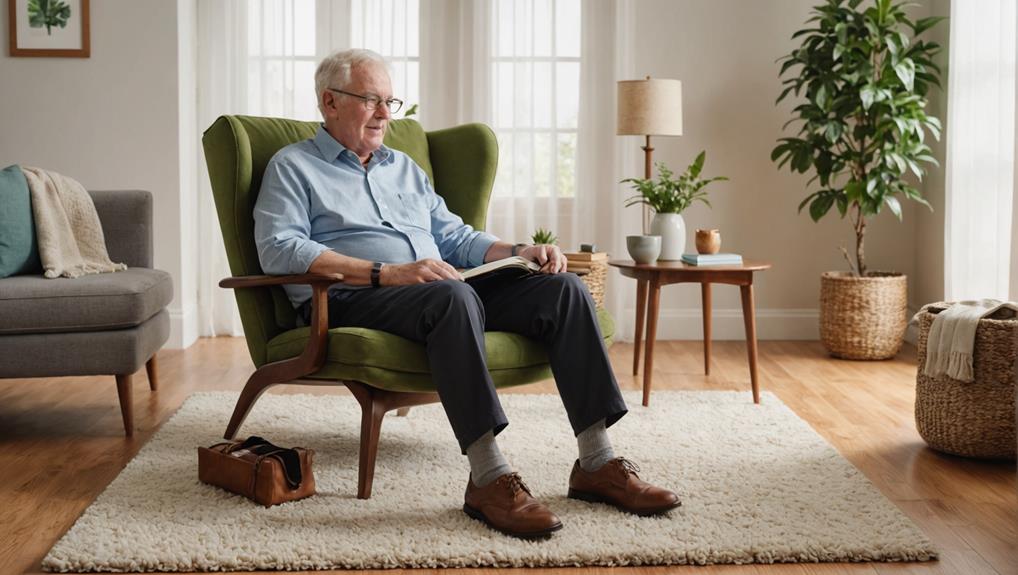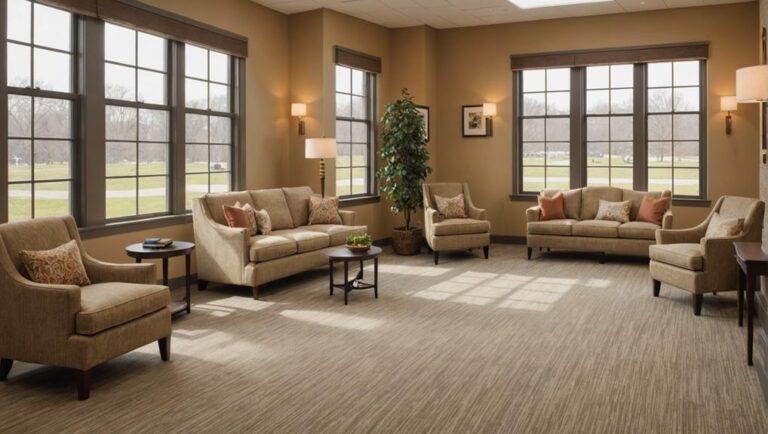To choose comfortable flooring for seniors, start by evaluating mobility needs in their living space. Opt for slip-resistant materials like textured vinyl or rubber to enhance safety. Prioritize cushioning, as soft carpets, cork, or rubber reduce joint impact while providing warmth. Consider temperature insulation for comfort and look for easy-to-maintain options like vinyl or laminate. Aesthetic appeal matters too; light colors and patterns can make spaces feel inviting and easier to clean. Finally, keep your budget in mind while exploring affordable and durable choices. There's so much more to discover about creating a safe and comfortable environment for seniors.
Assessing Mobility Needs
When it comes to choosing flooring for seniors, understanding mobility needs is essential. As people age, their mobility may be affected, making it important to contemplate how flooring can impact their daily lives. Start by evaluating the home layout. Is it open and spacious, or does it have tight corners and narrow hallways? Flooring should facilitate easy movement, especially for those who use mobility aids like walkers or canes.
Next, think about the types of activities your loved one engages in at home. They may need to get around the kitchen, bathroom, or living areas frequently. Smooth shifts between rooms are key to prevent tripping hazards. Avoid flooring that's slippery or uneven, as these can pose significant risks.
Reflect on the texture and grip of the flooring, as these elements can make a big difference in safety. For instance, textured vinyl or low-pile carpet can provide traction while still being easy to navigate.
Lastly, it's wise to involve your loved one in the decision-making process. Their input can help you understand their preferences and comfort levels, ensuring the chosen flooring meets their mobility needs. Selecting the right flooring isn't just about aesthetics; it's about creating a safe, accessible environment that supports their independence and well-being. By focusing on mobility needs and the home layout, you can make informed choices that enhance safety and comfort for seniors.
Evaluating Softness and Cushioning
Softness and cushioning play an indispensable role in creating a comfortable living environment for seniors. When choosing flooring, it's vital to take into account how different materials can enhance comfort and minimize the risk of injury. Look for options that incorporate cushioning materials, as these can greatly reduce the impact on joints and provide a more forgiving surface to walk on.
Carpet is a popular choice due to its inherent softness and the added warmth it provides. If you prefer hard flooring, contemplate options that include floor padding underneath, which can offer a similar cushioning effect. Materials like cork or rubber are excellent choices, as they not only provide a soft feel underfoot but also help absorb sound, creating a quieter home environment.
When evaluating softness, test various flooring samples by walking on them barefoot. You'll want to ascertain that the surface feels comfortable and supportive. Pay attention to how the material feels, especially in areas where seniors may spend a lot of time, such as the kitchen or living room.
Additionally, think about maintenance. Some soft flooring materials might require more upkeep to maintain their cushioning properties. Confirm that the flooring you choose is not only comfortable but also easy to clean and durable enough to withstand daily wear and tear.
Importance of Slip Resistance
How can you guarantee a safe environment for seniors at home? One of the key factors to evaluate is the flooring's slip resistance. As we age, our balance and mobility can decline, making slip resistance features absolutely essential. Choosing the right flooring can greatly reduce the risk of falls, which are a leading cause of injury among seniors.
When selecting flooring, pay close attention to slip resistant materials. Options like textured vinyl, rubber, or treated hardwood can offer the necessary grip to keep seniors stable while walking. These materials often have built-in slip resistance features that provide traction, even in wet conditions, ensuring safety in areas like kitchens and bathrooms where spills are more likely.
It's important to note that not all flooring is created equal when it comes to slip resistance. For instance, glossy tiles may look appealing but can be dangerously slippery. Instead, opt for options that have a matte finish or specific slip-resistant ratings. You can also check for certifications from organizations that test flooring for slip resistance, which can give you peace of mind.
Incorporating these slip resistance features into your flooring choice will not only enhance safety but also promote independence for seniors. By prioritizing slip resistant materials, you're creating an environment where they can navigate their home with confidence, ultimately contributing to their overall well-being. So, take the time to evaluate your flooring choices—it's a small step toward making a big difference in safety at home.
Maintenance and Cleaning Considerations
Maintaining a clean and safe environment is essential for seniors, and choosing the right flooring can simplify this task. When selecting flooring, consider the cleaning frequency you're willing to commit to. Materials like vinyl or laminate often require less frequent cleaning compared to carpets, which can trap dust and allergens.
Stain resistance is another vital factor. You'll want a flooring option that can withstand spills and accidents. Look for options that offer good stain resistance, especially if you have pets. Pet-friendly materials can make a significant difference in your home's maintenance needs.
Consider the maintenance tools you'll need. Simple tools like microfiber mops or vacuum cleaners designed for hard surfaces can make upkeep easier. Additionally, eco-friendly options are becoming increasingly available, allowing you to maintain a clean environment without harmful chemicals.
Odor control is important, too. Flooring that doesn't absorb smells can contribute to a fresher indoor atmosphere. Make sure to account for allergy considerations, as some materials can exacerbate respiratory issues.
Seasonal care is also worth noting. Certain floors may require specific treatments or cleaning products at different times of the year. For instance, you might need to use a special cleaner for winter salt residue or summer humidity.
Temperature and Comfort Factors
When choosing flooring, consider how well it insulates and retains heat, as this can greatly affect your comfort, especially during colder months. The surface texture also plays a role; warmer materials can make a space feel cozier underfoot. By focusing on these factors, you can create a more inviting environment that meets your needs.
Insulation and Heat Retention
Many seniors find that comfortable flooring can greatly enhance their living environment, especially regarding insulation and heat retention. Choosing the right flooring can notably impact how warm or cool your home feels, which is essential for maintaining comfort as temperatures fluctuate.
When considering insulation materials, look for options like cork, carpet, or vinyl, which can provide superior thermal insulation. These materials not only help keep your space warmer in the winter but also contribute to energy efficiency, potentially lowering your heating bills. Carpeting, in particular, can act as an insulator, trapping heat and creating a cozy atmosphere.
Additionally, pay attention to the flooring's underlayment. A quality underlayment can add an extra layer of insulation, enhancing heat retention and providing a softer feel underfoot, which is beneficial for seniors who may be more sensitive to temperature changes.
Surface Texture and Warmth
The choice of flooring surface texture plays a significant role in how warm and comfortable a space feels. When selecting flooring for seniors, you'll want to take into account both surface durability and the material options that provide a cozy atmosphere. A soft, textured finish can help maintain warmth underfoot, making it a safe and inviting choice.
Here are some key factors to keep in mind:
- Comfort: A plush surface can reduce strain on joints, offering a softer landing for those accidental falls.
- Warmth: Materials like cork or carpet can help keep feet warm, especially during colder months.
- Safety: Textured surfaces provide better grip, reducing the risk of slips and falls.
Aesthetic Appeal and Design
Choosing flooring that's both comfortable and visually appealing can greatly enhance a senior's living space. When selecting your flooring, consider how color choices and pattern selection can impact not just the aesthetics but also the overall safety and comfort of your environment. Light colors can make a space feel larger and brighter, while darker shades can create a cozy atmosphere. Patterns, on the other hand, can help disguise dirt and wear, making maintenance easier.
Here's a simple guide to help you visualize potential options:
| Color Choices | Pattern Selection | Safety Considerations |
|---|---|---|
| Soft pastels | Subtle textures | Non-slip surfaces |
| Neutral tones | Geometric designs | Low-profile edges |
| Warm earth tones | Natural motifs | Cushioned underlay |
| Bright accents | Floral patterns | Easy-to-navigate layouts |
When choosing your flooring, think about how the design complements your existing decor and personal style. A visually pleasing environment can greatly improve mood and promote a sense of well-being. Additionally, opt for flooring materials that are easy to clean and maintain, as this can reduce the risk of slips and falls. By prioritizing both aesthetic appeal and practical safety features, you can create a space that feels inviting while ensuring comfort and security for seniors.
Budgeting for Flooring Options
When budgeting for flooring options, it's crucial to assess your financial resources first. You can explore affordable materials that provide comfort without sacrificing style, ensuring your space remains welcoming. Additionally, consider the long-term costs, including maintenance and durability, to make a wise investment that meets your needs.
Assessing Financial Resources
While you may be enthusiastic to find the perfect flooring for a loved one, it's essential to first assess your financial resources to guarantee you stay within budget. Understanding your financial situation helps you make informed choices that prioritize safety and comfort without breaking the bank.
Consider these points when budgeting for flooring options:
- Explore financial assistance options: Research local programs that may help cover flooring costs for seniors.
- Look for senior discounts: Many retailers offer special pricing for seniors, which can greatly reduce expenses.
- Plan for installation costs: Don't forget to account for professional installation, as it's important for ensuring the flooring is safe and secure.
Taking the time to evaluate your financial resources can relieve stress and help you focus on selecting the best flooring for your loved one. Remember, the goal is to create a safe and comfortable environment that enhances their quality of life. By being proactive about budgeting, you can find the ideal flooring solution that meets both safety standards and financial needs.
Exploring Affordable Materials
Finding the right flooring doesn't have to drain your wallet—there are several affordable materials that offer both comfort and safety for seniors. One great choice is vinyl options, which are not only budget-friendly but also water-resistant and easy to clean. You'll find various designs that mimic the look of wood or tile, providing an aesthetic appeal without the high cost.
Carpet tiles are another option worth considering. They offer soft cushioning underfoot and can be easily replaced if damaged. Plus, their modular nature allows for creative designs that can brighten up a space.
For those seeking laminate durability, you'll appreciate its scratch- and dent-resistant qualities, making it an excellent choice for active households. Rubber flooring is another safe alternative, offering excellent traction and cushioning, ideal for preventing slips.
Lastly, don't overlook cork benefits; it's naturally antimicrobial and provides a warm, cushioned feel that's easy on the joints. With various tile varieties available, you can create a stylish yet functional space without overspending. Each of these options guarantees that your flooring remains safe and comfortable for seniors.
Long-Term Cost Considerations
Considering the long-term implications of your flooring choice is just as important as selecting affordable materials. When budgeting for flooring options, you should think beyond the initial investment. Opting for materials with lifetime durability can save you money in the long run, reducing the need for frequent replacements. Additionally, high-quality flooring can enhance your home's resale value, making it a wise financial choice.
Here are a few emotional considerations to keep in mind:
- Peace of Mind: Knowing your floors will last and remain safe for years.
- Comfort and Security: A stable, slip-resistant surface can help prevent falls.
- Aesthetic Appeal: Beautiful flooring can elevate your home's ambiance and make it more inviting.
Frequently Asked Questions
What Types of Flooring Are Best for Wheelchair Accessibility?
When considering flooring for wheelchair accessibility, you'll want to prioritize smooth, even surfaces that minimize obstacles. Hardwoods or vinyl can work well, but make certain they're paired with proper wheelchair ramps for easy changes. Avoid flooring textures that can hinder movement, like shag carpets or uneven tiles. Opt for low-pile carpets or sleek laminate, as they provide stability and safety, allowing for seamless navigation throughout your space.
How Can I Reduce Noise Levels From Flooring Choices?
To reduce noise levels from flooring choices, consider soundproofing techniques like adding underlayment or acoustic mats. These materials can greatly dampen sound transmission. When selecting flooring materials, look for options like cork or carpet, which naturally absorb sound. You might also want to avoid hard surfaces like tile or laminate, as they can amplify noise. Balancing aesthetics with safety is key, so choose stylish options that also enhance your home's tranquility.
Are Eco-Friendly Flooring Options Suitable for Seniors?
When considering eco-friendly flooring options, you'll find that many natural materials, like bamboo or cork, are not only sustainable but also provide great slip resistance. These materials reduce the risk of slips and falls, ensuring safety in your home. Plus, they often bring an aesthetic warmth that enhances your living space. Just be sure to choose products that are certified for low VOC emissions to promote a healthier indoor environment.
What Is the Lifespan of Different Flooring Materials?
You wouldn't believe how long some flooring materials can last! When considering flooring durability, hardwood can last up to 100 years with proper care, while vinyl typically lasts 10-20 years. Tile is a champion, often exceeding 20 years, but maintenance requirements differ. Hardwood needs regular refinishing, while vinyl and tile just require occasional cleaning. Choosing the right flooring is essential for a safe, aesthetically pleasing environment that stands the test of time and usage.
Can I Install New Flooring Over Existing Floors?
Yes, you can install new flooring over existing floors, but there are a few things to take into account first. Make sure the existing floors are in good condition, level, and free from moisture. Proper flooring installation is vital for safety and aesthetics. If you choose to go this route, be mindful of the height difference it may create, especially near doorways. Always prioritize a smooth, secure surface to avoid tripping hazards.




